Tailoring Rheological, Viscoelastic, and Starch Structural Properties in Plant-Based Beverages via Homolactic Fermentation of Quinoa and Chickpea Flour Blends
Abstract
1. Introduction
2. Materials and Methods
2.1. Plant-Based Sources
2.2. Flours Preparation
2.3. Differential Scanning Calorimetry Analysis
2.4. Pasting Properties of Quinoa and Chickpea Flour
2.5. Preparation of the Plant-Based Beverages
2.6. Fermentation Process
2.7. Physicochemical Analysis of the Fermentation Process
2.8. Physical Properties of Plant-Based Beverages
2.8.1. Determination of the Water-Holding Capacity
2.8.2. Rheological Measurements of Plant-Based Beverages
2.9. Fourier Transform-Infrared Spectroscopy (FTIR)
2.10. Statistical Analysis
3. Results and Discussion
3.1. Thermal Properties of Quinoa and Chickpea Flour
3.2. Pasting Properties of Quinoa-to-Chickpea Flour Ratios
3.3. Plant-Based Beverage Fermentation
3.4. Water-Holding Capacity of Beverages After Fermentation
3.5. Effect of Fermentation on the Viscosity of Quinoa and Chickpea Beverages
3.6. Changes in the Viscoelasticity Behavior After the Fermentation
3.7. Fourier Transform-Infrared Spectroscopy of Plant-Based Beverages
4. Conclusions
Supplementary Materials
Author Contributions
Funding
Data Availability Statement
Conflicts of Interest
Abbreviations
| CF | Chickpea flour |
| PBB | Plant-based beverage |
| QF | Quinoa flour |
| TTA | Total titratable acidity |
| WHC | Water-Holding capacity |
References
- Gocer, E.M.C.; Koptagel, E. Production and evaluation of microbiological & rheological characteristics of kefir beverages made from nuts. Food Biosci. 2023, 52, 102367. [Google Scholar] [CrossRef]
- Nawaz, M.A.; Buckow, R.; Katopo, L.; Stockmann, R. Plant-based beverages. In Engineering Plant-Based Food Systems; Elsevier: Amsterdam, The Netherlands, 2023; pp. 99–129. [Google Scholar] [CrossRef]
- Siddiqui, S.A.; Mehany, T.; Schulte, H.; Pandiselvam, R.; Nagdalian, A.A.; Golik, A.B.; Shah, M.A.; Shahbaz, H.M.; Maqsood, S. Plant-Based Milk–Thoughts of Researchers and Industries on What Should Be Called as ‘milk’. Food Rev. Int. 2024, 40, 1703–1730. [Google Scholar] [CrossRef]
- Hidalgo-Fuentes, B.; de Jesús-José, E.; Cabrera-Hidalgo, A.d.J.; Sandoval-Castilla, O.; Espinosa-Solares, T.; González-Reza, R.M.; Zambrano-Zaragoza, M.L.; Liceaga, A.M.; Aguilar-Toalá, J.E. Plant-Based Fermented Beverages: Nutritional Composition, Sensory Properties, and Health Benefits. Foods 2024, 13, 844. [Google Scholar] [CrossRef] [PubMed]
- Ammann, J.; Grande, A.; Inderbitzin, J.; Guggenbühl, B. Understanding Swiss consumption of plant-based alternatives to dairy products. Food Qual. Prefer. 2023, 110, 104947. [Google Scholar] [CrossRef]
- Deziderio, M.A.; de Souza, H.F.; Kamimura, E.S.; Petrus, R.R. Plant-Based Fermented Beverages: Development and Characterization. Foods 2023, 12, 4128. [Google Scholar] [CrossRef]
- Patra, T.; Rinnan, Å.; Olsen, K. The Physical Stability of Plant-Based Drinks and the Analysis Methods Thereof; Elsevier B.V.: Amsterdam, The Netherlands, 2021. [Google Scholar] [CrossRef]
- Fazla, S.N.M.; Marzlan, A.A.; Hussin, A.S.M.; Rahim, M.H.A.; Madzuki, I.N.; Mohsin, A.Z. Physicochemical, microbiological, and sensorial properties of chickpea yogurt analogue produced with different types of stabilizers. Discov. Food 2023, 3, 19. [Google Scholar] [CrossRef]
- Dhankhar, J.; Kundu, P. Stability Aspects of Non-Dairy Milk Alternatives. 4 March 2021. Available online: https://www.intechopen.com/chapters/75536 (accessed on 12 April 2025).
- Huang, K.; Liu, Y.; Zhang, Y.; Cao, H.; Luo, D.-K.; Yi, C.; Guan, X. Formulation of plant-based yoghurt from soybean and quinoa and evaluation of physicochemical, rheological, sensory and functional properties. Food Biosci. 2022, 49, 101831. [Google Scholar] [CrossRef]
- Rincon, L.; Botelho, R.B.A.; de Alencar, E.R. Development of novel plant-based milk based on chickpea and coconut. LWT 2020, 128, 109479. [Google Scholar] [CrossRef]
- Tiga, B.H.; Kumcuoglu, S.; Vatansever, M.; Tavman, S. Thermal and pasting properties of Quinoa—Wheat flour blends and their effects on production of extruded instant noodles. J. Cereal Sci. 2021, 97, 103120. [Google Scholar] [CrossRef]
- Sidhu, M.K.; Lyu, F.; Sharkie, T.P.; Ajlouni, S.; Ranadheera, C.S. Probiotic yogurt fortified with chickpea flour: Physico-chemical properties and probiotic survival during storage and simulated gastrointestinal transit. Foods 2020, 9, 1144. [Google Scholar] [CrossRef]
- Yan, X.; McClements, D.J.; Luo, S.; Ye, J.; Liu, C. A review of the effects of fermentation on the structure, properties, and application of cereal starch in foods. Crit. Rev. Food Sci. Nutr. 2024, 65, 2323–2342. [Google Scholar] [CrossRef] [PubMed]
- Ahsan, S.; Khaliq, A.; Chughtai, M.F.J.; Nadeem, M.; Tahir, A.B.; Din, A.A.; Ntsefong, G.N.; Shariati, M.A.; Rebezov, M.; Yessimbekov, Z.; et al. Technofunctional quality assessment of soymilk fermented with Lactobacillus acidophilus and Lactobacillus casei. Biotechnol. Appl. Biochem. 2022, 69, 172–182. [Google Scholar] [CrossRef] [PubMed]
- Abdollahzadeh, S.M.; Zahedani, M.R.; Rahmdel, S.; Hemmati, F.; Mazloomi, S.M. Development of Lactobacillus acidophilus-fermented milk fortified with date extract. LWT 2018, 98, 577–582. [Google Scholar] [CrossRef]
- Meinlschmidt, P.; Ueberham, E.; Lehmann, J.; Schweiggert-Weisz, U.; Eisner, P. Immunoreactivity, sensory and physicochemical properties of fermented soy protein isolate. Food Chem. 2016, 205, 229–238. [Google Scholar] [CrossRef]
- Łopusiewicz, Ł.; Drozłowska, E.; Trocer, P.; Kwiatkowski, P.; Bartkowiak, A.; Gefrom, A.; Sienkiewicz, M. The Effect of Fermentation with Kefir Grains on the Physicochemical and Antioxidant Properties of Beverages from Blue Lupin (Lupinus angustifolius L.) Seeds. Molecules 2020, 25, 5791. [Google Scholar] [CrossRef]
- Hong, J.; Guo, W.; Chen, P.; Liu, C.; Wei, J.; Zheng, X.; Saeed Omer, S.H. Effects of Bifidobacteria Fermentation on Physico-Chemical, Thermal and Structural Properties of Wheat Starch. Foods 2022, 11, 2585. [Google Scholar] [CrossRef]
- Ludena Urquizo, F.E.; García Torres, S.M.; Tolonen, T.; Jaakkola, M.; Pena-Niebuhr, M.G.; von Wright, A.; Repo-Carrasco-Valencia, R.; Korhonen, H.; Plumed-Ferrer, C. Development of a fermented quinoa-based beverage. Food Sci. Nutr. 2017, 5, 602–608. [Google Scholar] [CrossRef]
- Mefleh, M.; Faccia, M.; Natrella, G.; De Angelis, D.; Pasqualone, A.; Caponio, F.; Summo, C. Development and Chemical-Sensory Characterization of Chickpeas-Based Beverages Fermented with Selected Starters. Foods 2022, 11, 3578. [Google Scholar] [CrossRef]
- Hurtado-Murillo, J.; Franco, W.; Contardo, I. Role of Quinoa (Chenopodium quinoa Willd) and Chickpea (Cicer arietinum L.) Ratio in Physicochemical Stability and Microbiological Quality of Fermented Plant-Based Beverages during Storage. Foods 2024, 13, 2462. [Google Scholar] [CrossRef]
- Hurtado-Murillo, J.; Franco, W.; Contardo, I. Impact of homolactic fermentation using Lactobacillus acidophilus on plant-based protein hydrolysis in quinoa and chickpea flour blended beverages. Food Chem. 2025, 463, 141110. [Google Scholar] [CrossRef]
- Contardo, I.; James, B.; Bouchon, P. Microstructural characterization of vacuum-fried matrices and their influence on starch digestion. Food Struct. 2020, 25, 100146. [Google Scholar] [CrossRef]
- Huang, L.; Dong, J.-L.; Zhang, K.-Y.; Zhu, Y.; Shen, R.-L.; Qu, L. Thermal processing influences the physicochemical properties, in vitro digestibility and prebiotics potential of germinated highland barley. LWT 2021, 140, 110814. [Google Scholar] [CrossRef]
- Qiu, L.; Zhang, M.; Chang, L. Effects of lactic acid bacteria fermentation on the phytochemicals content, taste and aroma of blended edible rose and shiitake beverage. Food Chem. 2023, 405, 134722. [Google Scholar] [CrossRef] [PubMed]
- Xu, X.; Cui, H.; Yuan, Z.; Xu, J.; Li, J.; Liu, J.; Liu, H.; Zhu, D. Effects of different combinations of probiotics on rheology, microstructure, and moisture distribution of soy materials-based yogurt. J. Food Sci. 2022, 87, 2820–2830. [Google Scholar] [CrossRef] [PubMed]
- Xie, Q.; Liu, X.; Liu, H.; Zhang, Y.; Xiao, S.; Ding, W.; Lyu, Q.; Fu, Y.; Wang, X. Insight into the effect of garlic peptides on the physicochemical and anti-staling properties of wheat starch. Int. J. Biol. Macromol. 2023, 229, 363–371. [Google Scholar] [CrossRef] [PubMed]
- Zhao, T.; Li, X.; Zhu, R.; Ma, Z.; Liu, L.; Wang, X.; Hu, X. Effect of natural fermentation on the structure and physicochemical properties of wheat starch. Carbohydr. Polym. 2019, 218, 163–169. [Google Scholar] [CrossRef]
- Ghoshal, G.; Kaushal, K. Extraction, characterization, physicochemical and rheological properties of two different varieties of chickpea starch. Legume Sci. 2020, 2, e17. [Google Scholar] [CrossRef]
- Li, G.; Zhu, F. Quinoa Starch: Structure, Properties, and Applications; Elsevier Ltd.: Amsterdam, The Netherlands, 2018. [Google Scholar] [CrossRef]
- Gałkowska, D.; Witczak, T.; Witczak, M. Ancient Wheat and Quinoa Flours as Ingredients for Pasta Dough—Evaluation of Thermal and Rheological Properties. Molecules 2021, 26, 7033. [Google Scholar] [CrossRef]
- Sarıkaya, S.; İnanlar, B.; Younis, H.G.R.; Zhao, G.; Ye, F. Chickpea (Cicer arietinum Linn.) starch: Extraction, composition, structure, properties, modifications and food applications. Grain Oil Sci. Technol. 2025, 8, 118–136. [Google Scholar] [CrossRef]
- Singh, N.; Sandhu, K.S.; Kaur, M. Characterization of starches separated from Indian chickpea (Cicer arietinum L.) cultivars. J. Food Eng. 2004, 63, 441–449. [Google Scholar] [CrossRef]
- Kaur, R.; Prasad, K. Technological, processing and nutritional aspects of chickpea (Cicer arietinum)—A review. Trends Food Sci. Technol. 2021, 109, 448–463. [Google Scholar] [CrossRef]
- Kaur, M.; Singh, N. Relationships Between Selected Properties of Seeds, Flours, and Starches from Different Chickpea Cultivars. Int. J. Food Prop. 2006, 9, 597–608. [Google Scholar] [CrossRef]
- Huang, J.; Schols, H.A.; van Soest, J.J.G.; Jin, Z.; Sulmann, E.; Voragen, A.G.J. Physicochemical properties and amylopectin chain profiles of cowpea, chickpea and yellow pea starches. Food Chem. 2007, 101, 1338–1348. [Google Scholar] [CrossRef]
- Jan, K.N.; Panesar, P.S.; Rana, J.C.; Singh, S. Structural, thermal and rheological properties of starches isolated from Indian quinoa varieties. Int. J. Biol. Macromol. 2017, 102, 315–322. [Google Scholar] [CrossRef]
- Nandan, A.; Koirala, P.; Dutt Tripathi, A.; Vikranta, U.; Shah, K.; Gupta, A.J.; Agarwal, A.; Nirmal, N. Nutritional and functional perspectives of pseudocereals. Food Chem. 2024, 448, 139072. [Google Scholar] [CrossRef]
- Culetu, A.; Susman, I.E.; Duta, D.E.; Belc, N. Nutritional and Functional Properties of Gluten-Free Flours. Appl. Sci. 2021, 11, 6283. [Google Scholar] [CrossRef]
- Miao, M.; Zhang, T.; Jiang, B. Characterisations of kabuli and desi chickpea starches cultivated in China. Food Chem. 2009, 113, 1025–1032. [Google Scholar] [CrossRef]
- Contardo, I.; Guzmán, F.; Enrione, J. Conformational and Structural Changes in Chickpea Proteins Caused by Simulated Salivary Alterations in the Elderly. Foods 2023, 12, 3668. [Google Scholar] [CrossRef]
- Zhang, B.; Qiao, D.; Zhao, S.; Lin, Q.; Wang, J.; Xie, F. Starch-based food matrices containing protein: Recent understanding of morphology, structure, and properties. Trends Food Sci. Technol. 2021, 114, 212–231. [Google Scholar] [CrossRef]
- Lu, L.; He, C.; Liu, B.; Wen, Q.; Xia, S. Incorporation of chickpea flour into biscuits improves the physicochemical properties and in vitro starch digestibility. LWT 2022, 159, 113222. [Google Scholar] [CrossRef]
- Millar, K.A.; Barry-Ryan, C.; Burke, R.; McCarthy, S.; Gallagher, E. Dough properties and baking characteristics of white bread, as affected by addition of raw, germinated and toasted pea flour. Innov. Food Sci. Emerg. Technol. 2019, 56, 102189. [Google Scholar] [CrossRef]
- Mohammed, I.; Ahmed, A.R.; Senge, B. Effects of chickpea flour on wheat pasting properties and bread making quality. J. Food Sci. Technol. 2014, 51, 1902–1910. [Google Scholar] [CrossRef] [PubMed]
- Kaur, M.; Singh, N. Studies on functional, thermal and pasting properties of flours from different chickpea (Cicer arietinum L.) cultivars. Food Chem. 2005, 91, 403–411. [Google Scholar] [CrossRef]
- Halim, A.; Torley, P.J.; Farahnaky, A.; Majzoobi, M. Investigating the Effects of Acid Hydrolysis on Physicochemical Properties of Quinoa and Faba Bean Starches as Compared to Cassava Starch. Foods 2024, 13, 3885. [Google Scholar] [CrossRef]
- Juhász, R.; Salgó, A. Pasting Behavior of Amylose, Amylopectin and Their Mixtures as Determined by RVA Curves and First Derivatives. Starch—Stärke 2008, 60, 70–78. [Google Scholar] [CrossRef]
- Feng, Y.Y.; Zhu, Y.; Wang, Z.; Li, X. Effects of whole quinoa flour addition on the pasting property, dough rheology, and steam bread textural property of wheat flour. Int. Food Res. J. 2023, 30, 1212–1220. [Google Scholar] [CrossRef]
- Yang, C.; Zhong, F.; Goff, H.D.; Li, Y. Study on starch-protein interactions and their effects on physicochemical and digestible properties of the blends. Food Chem. 2019, 280, 51–58. [Google Scholar] [CrossRef]
- Eliasson, A.-C.; Larsson, K. Cereals in Breadmaking; Routledge: London, UK, 2018. [Google Scholar] [CrossRef]
- Balet, S.; Guelpa, A.; Fox, G.; Manley, M. Rapid Visco Analyser (RVA) as a Tool for Measuring Starch-Related Physiochemical Properties in Cereals: A Review; Springer Science and Business Media, LLC: Berlin/Heidelberg, Germany, 2019. [Google Scholar] [CrossRef]
- Zhang, J.; Liu, Y.; Wang, P.; Zhao, Y.; Zhu, Y.; Xiao, X. The Effect of Protein–Starch Interaction on the Structure and Properties of Starch, and Its Application in Flour Products. Foods 2025, 14, 778. [Google Scholar] [CrossRef]
- Jana, M.; Bandyopadhyay, S. Restricted dynamics of water around a protein–carbohydrate complex: Computer simulation studies. J. Chem. Phys. 2012, 137, 055102. [Google Scholar] [CrossRef]
- Sayar, S.; Koksel, H.; Turhan, M. The Effects of Protein-Rich Fraction and Defatting on Pasting Behavior of Chickpea Starch. Starch—Stärke 2005, 57, 599–604. [Google Scholar] [CrossRef]
- Singh, N.; Kaur, S.; Isono, N.; Noda, T. Genotypic diversity in physico-chemical, pasting and gel textural properties of chickpea (Cicer arietinum L.). Food Chem. 2010, 122, 65–73. [Google Scholar] [CrossRef]
- Singh, N. Functional and physicochemical properties of pulse starch. In Pulse Foods: Processing, Quality and Nutraceutical Applications; Elsevier: Amsterdam, The Netherlands, 2020; pp. 87–112. [Google Scholar] [CrossRef]
- Gostin, A.I. Effects of substituting refined wheat flour with wholemeal and quinoa flour on the technological and sensory characteristics of salt-reduced breads. LWT 2019, 114, 108412. [Google Scholar] [CrossRef]
- Scott, G.; Awika, J.M. Effect of protein–starch interactions on starch retrogradation and implications for food product quality. Compr. Rev. Food Sci. Food Saf. 2023, 22, 2081–2111. [Google Scholar] [CrossRef] [PubMed]
- Bender, D.; Schönlechner, R. Recent developments and knowledge in pseudocereals including technological aspects. Acta Aliment. 2021, 50, 583–609. [Google Scholar] [CrossRef]
- Wang, S.; Opassathavorn, A.; Zhu, F. Influence of Quinoa Flour on Quality Characteristics of Cookie, Bread and Chinese Steamed Bread. J. Texture Stud. 2015, 46, 281–292. [Google Scholar] [CrossRef]
- Zhou, S.; Wang, Y.; Hu, Q.; Li, J.; Chen, J.; Liu, X. Enhancement of nutritional quality of chickpea flour by solid-state fermentation for improvement of in vitro antioxidant activity and protein digestibility. Food Chem. 2025, 468, 142418. [Google Scholar] [CrossRef]
- Qian, J.; Kuhn, M. Characterization of Amaranthus cruentus and Chenopodium quinoa Starch. Starch—Stärke 1999, 51, 116–120. [Google Scholar] [CrossRef]
- Lorenz, K. Quinoa (Chenopodium quinoa) Starch—Physico-chemical Properties and Functional Characteristics. Starch—Stärke 1990, 42, 81–86. [Google Scholar] [CrossRef]
- Inglett, G.E.; Chen, D.; Liu, S.X. Pasting and rheological properties of quinoa-oat composites. Int. J. Food Sci. Technol. 2015, 50, 878–884. [Google Scholar] [CrossRef]
- Wu, G.; Morris, C.F.; Murphy, K.M. Quinoa Starch Characteristics and Their Correlations with the Texture Profile Analysis (TPA) of Cooked Quinoa. J. Food Sci. 2017, 82, 2387–2395. [Google Scholar] [CrossRef]
- Li, C.; Hu, Y.; Huang, T.; Gong, B.; Yu, W.-W. A combined action of amylose and amylopectin fine molecular structures in determining the starch pasting and retrogradation property. Int. J. Biol. Macromol. 2020, 164, 2717–2725. [Google Scholar] [CrossRef]
- Ayub, M.; Castro-Alba, V.; Lazarte, C.E. Development of an instant-mix probiotic beverage based on fermented quinoa with reduced phytate content. J. Funct. Foods 2021, 87, 104831. [Google Scholar] [CrossRef]
- Canon, F.; Maillard, M.B.; Famelart, M.H.; Thierry, A.; Gagnaire, V. Mixed dairy and plant-based yogurt alternatives: Improving their physical and sensorial properties through formulation and lactic acid bacteria cocultures. Curr. Res. Food Sci. 2022, 5, 665–676. [Google Scholar] [CrossRef]
- Chekdid, A.A.; Kahn, C.J.F.; Prévot, E.; Ferrières, M.; Lemois, B.; Choquet, C.; Linder, M. Mixture design applied for formulation and characterization of vegetal-based fermented products. LWT 2021, 146, 111336. [Google Scholar] [CrossRef]
- Boeck, T.; Ispiryan, L.; Hoehnel, A.; Sahin, A.W.; Coffey, A.; Zannini, E.; Arendt, E.K. Lentil-Based Yogurt Alternatives Fermented with Multifunctional Strains of Lactic Acid Bacteria—Techno-Functional, Microbiological, and Sensory Characteristics. Foods 2022, 11, 2013. [Google Scholar] [CrossRef] [PubMed]
- Mu, H.; Dai, T.; Huang, S.; Wu, K.; Wang, M.; Tan, C.; Zhang, F.; Sheng, J.; Zhao, C. Physical and Chemical Properties, Flavor and Organoleptic Characteristics of a Walnut and Purple Rice Fermented Plant Drink. Foods 2024, 13, 400. [Google Scholar] [CrossRef] [PubMed]
- Lopes, M.; Pierrepont, C.; Duarte, C.M.; Filipe, A.; Medronho, B.; Sousa, I. Legume beverages from chickpea and lupin, as new milk alternatives. Foods 2020, 9, 1458. [Google Scholar] [CrossRef]
- Bianchi, F.; Rossi, E.A.; Gomes, R.G.; Sivieri, K. Potentially synbiotic fermented beverage with aqueous extracts of quinoa (Chenopodium quinoa Willd) and soy. Food Sci. Technol. Int. 2015, 21, 403–415. [Google Scholar] [CrossRef]
- Lorusso, A.; Coda, R.; Montemurro, M.; Rizzello, C.G. Use of selected lactic acid bacteria and quinoa flour for manufacturing novel yogurt-like beverages. Foods 2018, 7, 51. [Google Scholar] [CrossRef]
- Shao, D.; Zhang, J.; Shao, T.; Li, Y.; He, H.; Wang, Y.; Ma, J.; Cao, R.; Li, A.; Du, X. Modification of Structure, Pasting, and In Vitro Digestion Properties of Glutinous Rice Starch by Different Lactic Acid Bacteria Fermentation. Foods 2025, 14, 367. [Google Scholar] [CrossRef]
- Wang, H.; Liu, J.; Zhang, Y.; Li, S.; Liu, X.; Zhang, Y.; Zhao, X.; Shen, H.; Xie, F.; Xu, K.; et al. Insights into the hierarchical structure and physicochemical properties of starch isolated from fermented dough. Int. J. Biol. Macromol. 2024, 267, 131315. [Google Scholar] [CrossRef]
- Cichońska, P.; Domian, E.; Ziarno, M. Application of Optical and Rheological Techniques in Quality and Storage Assessment of the Newly Developed Colloidal-Suspension Products: Yogurt-Type Bean-Based Beverages. Sensors 2022, 22, 8348. [Google Scholar] [CrossRef] [PubMed]
- Bian, X.; Chen, J.-R.; Yang, Y.; Yu, D.-H.; Ma, Z.-Q.; Ren, L.-K.; Wu, N.; Chen, F.-L.; Liu, X.-F.; Wang, B.; et al. Effects of fermentation on the structure and physical properties of glutinous proso millet starch. Food Hydrocoll. 2022, 123, 107144. [Google Scholar] [CrossRef]
- Yuan, M.-L.; Lu, Z.-H.; Cheng, Y.-Q.; Li, L.-T. Effect of spontaneous fermentation on the physical properties of corn starch and rheological characteristics of corn starch noodle. J. Food Eng. 2008, 85, 12–17. [Google Scholar] [CrossRef]
- de Carvalho Alves, J.; de Souza, C.O.; de Matos Santos, L.; Viana, S.N.A.; de Jesus Assis, D.; Tavares, P.P.L.G.; Requião, E.d.R.; Ferro, J.M.R.B.d.S.; Roselino, M.N. Licuri Kernel (Syagrus coronata (Martius) Beccari): A Promising Matrix for the Development of Fermented Plant-Based Kefir Beverages. Foods 2024, 13, 2056. [Google Scholar] [CrossRef]
- Saleh, A.; Mohamed, A.A.; Alamri, M.S.; Hussain, S.; Qasem, A.A.; Ibraheem, M.A. Effect of Different Starches on the Rheological, Sensory and Storage Attributes of Non-fat Set Yogurt. Foods 2020, 9, 61. [Google Scholar] [CrossRef]
- Liu, G.; Ji, N.; Gu, Z.; Hong, Y.; Cheng, L.; Li, C. Molecular interactions in debranched waxy starch and their effects on digestibility and hydrogel properties. Food Hydrocoll. 2018, 84, 166–172. [Google Scholar] [CrossRef]
- Matalanis, A.M.; Campanella, O.H.; Hamaker, B.R. Storage retrogradation behavior of sorghum, maize and rice starch pastes related to amylopectin fine structure. J. Cereal Sci. 2009, 50, 74–81. [Google Scholar] [CrossRef]
- Liu, H.; Xu, X.; Cui, H.; Xu, J.; Yuan, Z.; Liu, J.; Li, C.; Li, J.; Zhu, D. Plant-Based Fermented Beverages and Key Emerging Processing Technologies. Food Rev. Int. 2022, 39, 5844–5863. [Google Scholar] [CrossRef]
- Huang, Z.; Li, Y.; Guo, T.; Xu, L.; Yuan, J.; Li, Z.; Yi, C. The Physicochemical Properties and Structure of Mung Bean Starch Fermented by Lactobacillus plantarum. Foods 2024, 13, 3409. [Google Scholar] [CrossRef]
- de Oliveira Barros, M.; Mattos, A.L.A.; de Almeida, J.S.; de Freitas Rosa, M.; de Brito, E.S. Effect of Ball-Milling on Starch Crystalline Structure, Gelatinization Temperature, and Rheological Properties: Towards Enhanced Utilization in Thermosensitive Systems. Foods 2023, 12, 2924. [Google Scholar] [CrossRef]
- Boulet-Audet, M.; Buffeteau, T.; Boudreault, S.; Daugey, N.; Pézolet, M. Quantitative Determination of Band Distortions in Diamond Attenuated Total Reflectance Infrared Spectra. J. Phys. Chem. B 2010, 114, 8255–8261. [Google Scholar] [CrossRef]
- Li, X.; Wei, S.; Gao, Z.; Zhao, R.; Wang, Z.; Fan, Y.; Cui, L.; Wang, Y. The influence of cooperative fermentation on the structure, crystallinity, and rheological properties of buckwheat starch. Curr. Res. Food Sci. 2024, 8, 100670. [Google Scholar] [CrossRef]
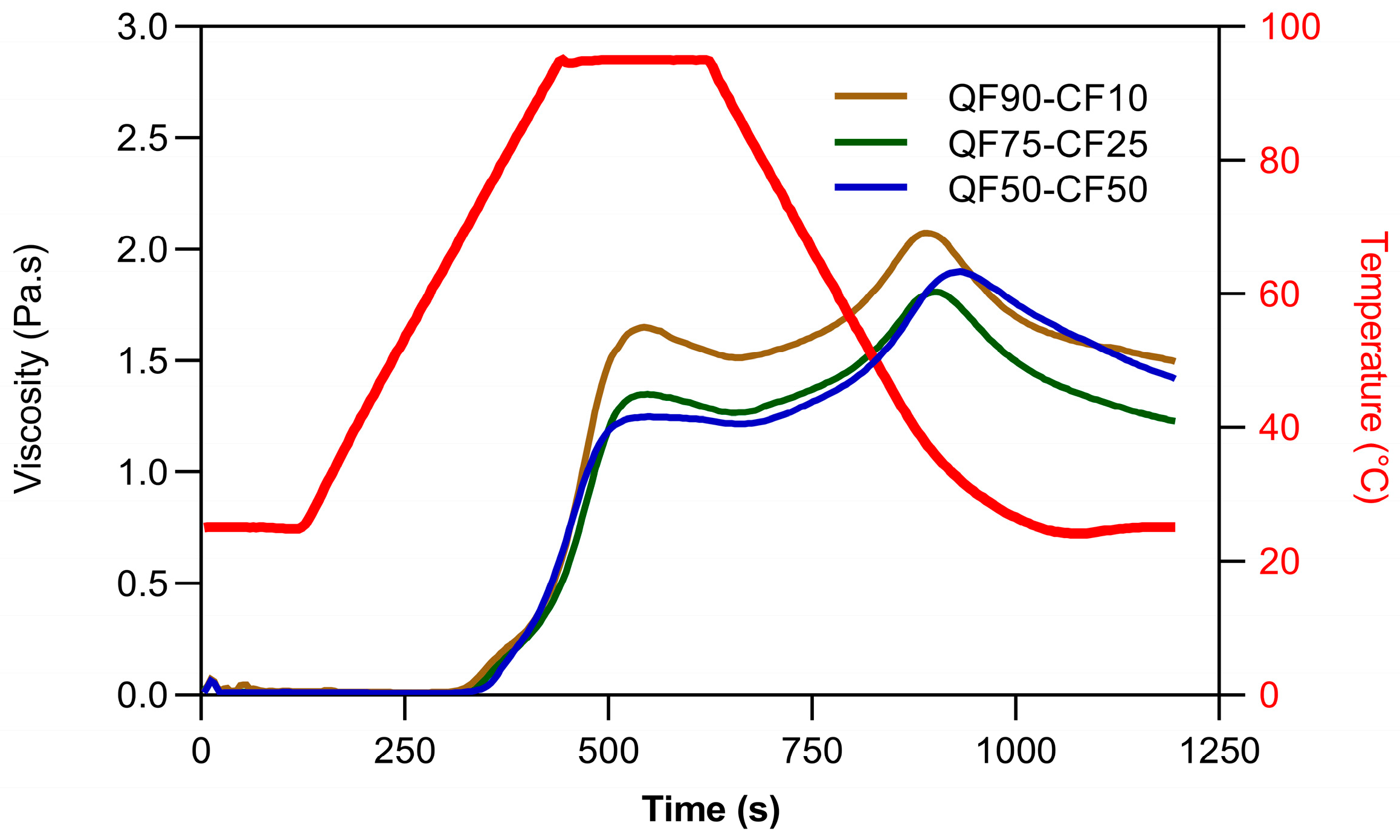
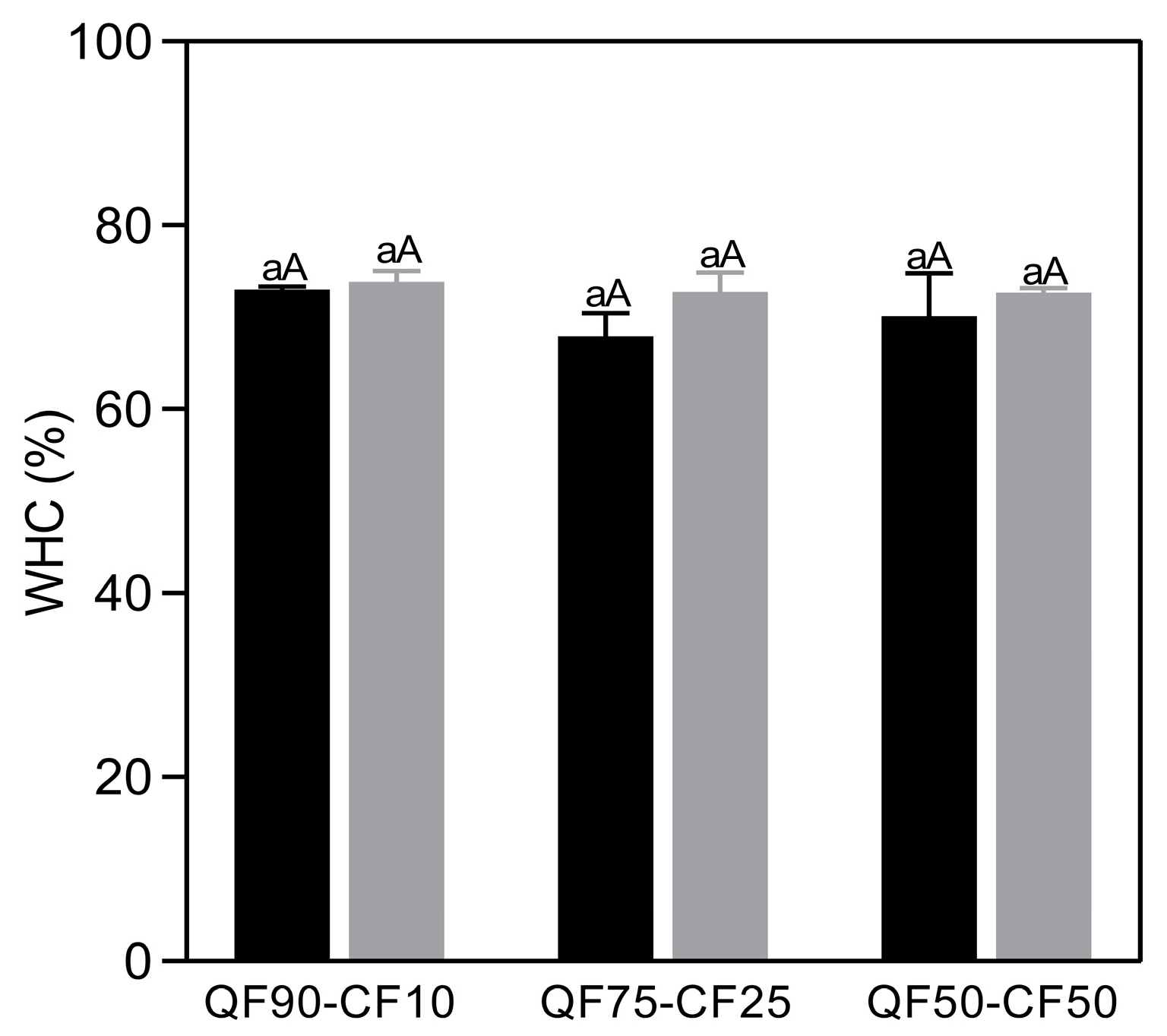
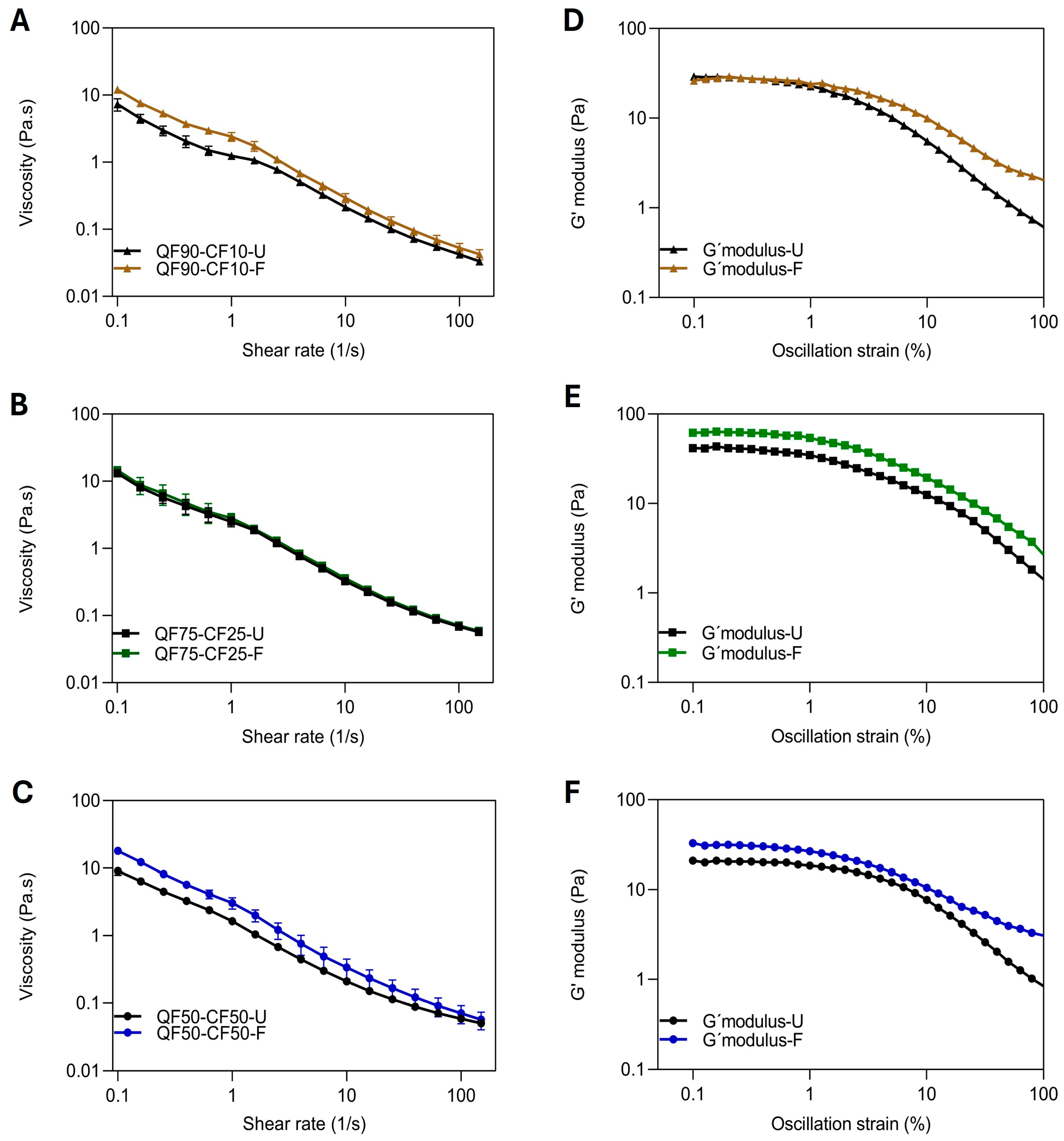
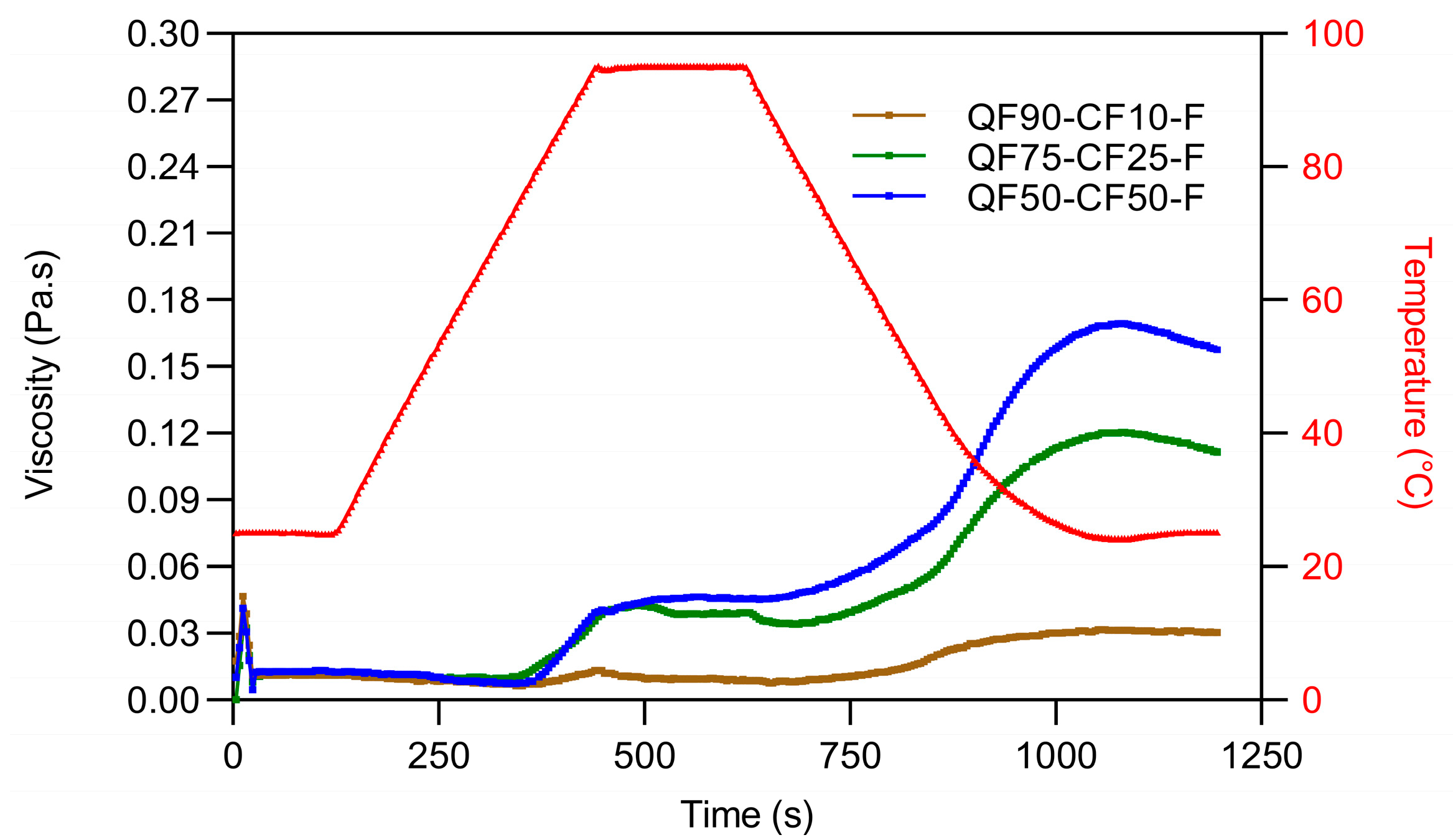
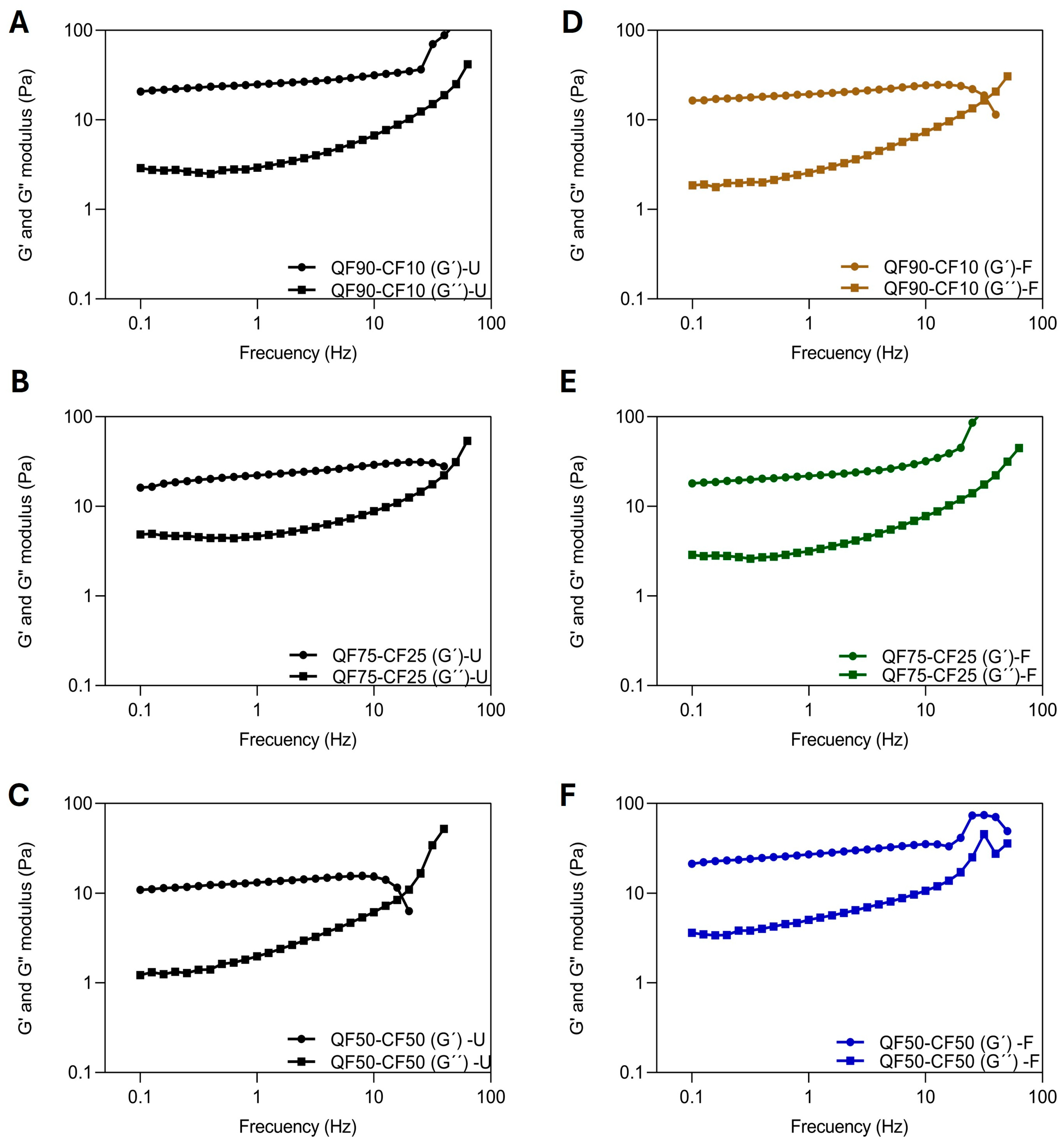
| Thermal Properties (°C) | Quinoa Flour | Chickpea Flour | ||
|---|---|---|---|---|
| Onset (To) | 63.6 ± 2.2 a | 68.3 ± 1.2 b | ||
| Peak (Tp) | 66.4 ± 0.7 a | 72.38 ± 1.2 b | ||
| Endset (Te) | 70.6 ± 1.6 a | 79.0 ± 0.4 b | ||
| Quinoa-to-Chickpea Flour Ratio | ||||
| Pasting Properties (Pa.s) | QF90-CF10 | QF75-CF25 | QF50-CF50 | |
| Peak Viscosity (PV) | 0.405 ± 0.0 a | 0.350 ± 0.0 a | 0.410 ± 0.1 a | |
| Breakdown Viscosity (BV) | 0.226 ± 0.0 a | 0.201 ± 0.1 a | 0.297 ± 0.0 b | |
| Setback Viscosity (SV) | 1.342 ± 0.1 a | 1.081 ± 0.0 a | 1.307 ± 0.1 a | |
| Final viscosity (FV) | 1.521 ± 0.0 a | 1.228 ± 0.1 a | 1.420 ± 0.0 a | |
| Beverage | ||||
|---|---|---|---|---|
| Condition | Parameters | QF90-CF10 | QF75-CF25 | QF50-CF50 |
| Unfermented samples | pH | 6.0 ± 0.0 Aa | 6.1 ± 0.0 Aa | 6.10 ± 0.1 Aa |
| TTA (%) | 0.3 ± 0.0 Aa | 0.2 ± 0.0 Aa | 0.2 ± 0.0 Aa | |
| Yield (g lactate/g glucose) | 0.0 ± 0.0 Aa | 0.0 ± 0.0 Aa | 0.0 ± 0.0 Aa | |
| °Brix | 10.7 ± 0.2 Aa | 9.9 ± 0.1 Aa | 8.7 ± 1.3 Ba | |
| Log CFU/mL | 2.3 ± 0.1 Aa | 2.3 ± 0.1 Aa | 2.5 ± 0.1 Aa | |
| Fermented samples | pH | 4.1 ± 0.04 Ab | 4.3± 0.0 Ab | 4.3 ± 0.1 Ab |
| TTA (%) | 0.4 ± 0.0 Ab | 0.4 ± 0.0 Ab | 0.5 ± 0.0 Bb | |
| Yield (g lactate/g glucose) | 1.0 ± 0.0 Ab | 0.9 ± 0.0 Ab | 1.0 ± 0.0 Ab | |
| °Brix | 10.0 ± 0.4 Aa | 9.6 ± 0.3 Aa | 7.3 ± 0.2 Ba | |
| Log CFU/mL | 7.9 ± 0.3 Ab | 9.1 ± 0.1 Ab | 7.9 ± 0.0 Ab | |
| μmax(log CFU/g/h) | 1.0 ± 0.0 a | 1.4 ± 0.0 b | 1.1 ± 0.11 a | |
| Growth T10-T0 (log CFU/10 h) | 5.6 ± 0.1 a | 6.8 ± 0.1 b | 5.4 ± 0.7 a | |
| Beverage | Fermentation Conditions | Amorphous Starch Region (cm−1) | Intermediate Region (cm−1) | Ordered Starch Region (cm−1) | DO (1047/1022) | DD (995/1022) |
|---|---|---|---|---|---|---|
| QF90-CF10 | Unfermented | 994 ± 0.0 Aa | 1022 ± 0.0 Aa | 1046 ± 0.0 Aa | 0.73 ± 0.0 Aa | 0.95 ± 0.0 Aa |
| Fermented | 994 ± 0.6 Aa | 1022 ± 0.0 Aa | 1046 ± 0.0 Aa | 0.72 ± 0.0 Aa | 0.94 ± 0.0 Aa | |
| QF75-CF25 | Unfermented | 994 ± 0.0 Aa | 1022 ± 0.0 Aa | 1046 ± 0.0 Aa | 0.70 ± 0.0 Aa | 0.94 ± 0.0 Aa |
| Fermented | 994 ± 0.0 Aa | 1021 ± 0.6 Aa | 1045 ± 0.1 Aa | 0.71 ± 0.0 Aa | 0.96 ± 0.0 Aa | |
| QF50-CF50 | Unfermented | 994 ± 0.0 Aa | 1022 ± 0.0 Aa | 1046 ± 0.0 Aa | 0.65 ± 0.0 Ba | 0.93 ± 0.0 Aa |
| Fermented | 994 ± 0.5 Aa | 1022 ± 0.0 Aa | 1046 ± 0.0 Aa | 0.71 ± 0.0 Ab | 0.97 ± 0.0 Ab |
Disclaimer/Publisher’s Note: The statements, opinions and data contained in all publications are solely those of the individual author(s) and contributor(s) and not of MDPI and/or the editor(s). MDPI and/or the editor(s) disclaim responsibility for any injury to people or property resulting from any ideas, methods, instructions or products referred to in the content. |
© 2025 by the authors. Licensee MDPI, Basel, Switzerland. This article is an open access article distributed under the terms and conditions of the Creative Commons Attribution (CC BY) license (https://creativecommons.org/licenses/by/4.0/).
Share and Cite
Hurtado-Murillo, J.; Franco, W.; Contardo, I. Tailoring Rheological, Viscoelastic, and Starch Structural Properties in Plant-Based Beverages via Homolactic Fermentation of Quinoa and Chickpea Flour Blends. Polysaccharides 2025, 6, 92. https://doi.org/10.3390/polysaccharides6040092
Hurtado-Murillo J, Franco W, Contardo I. Tailoring Rheological, Viscoelastic, and Starch Structural Properties in Plant-Based Beverages via Homolactic Fermentation of Quinoa and Chickpea Flour Blends. Polysaccharides. 2025; 6(4):92. https://doi.org/10.3390/polysaccharides6040092
Chicago/Turabian StyleHurtado-Murillo, John, Wendy Franco, and Ingrid Contardo. 2025. "Tailoring Rheological, Viscoelastic, and Starch Structural Properties in Plant-Based Beverages via Homolactic Fermentation of Quinoa and Chickpea Flour Blends" Polysaccharides 6, no. 4: 92. https://doi.org/10.3390/polysaccharides6040092
APA StyleHurtado-Murillo, J., Franco, W., & Contardo, I. (2025). Tailoring Rheological, Viscoelastic, and Starch Structural Properties in Plant-Based Beverages via Homolactic Fermentation of Quinoa and Chickpea Flour Blends. Polysaccharides, 6(4), 92. https://doi.org/10.3390/polysaccharides6040092






